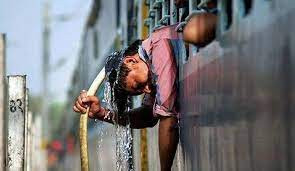
Air flow has increased in Dhaka. There is also light cloud movement. The temperature of Dhaka has dropped by more than 3 degrees Celsius in the last two days. However, the feeling of heat in Dhaka has not decreased much. Scientists blame the formation of thermal islands or heat islands in Dhaka as the reason for this.
Daytime heat accumulates in cities, mainly due to the loss of vegetation and wetlands and the construction of buildings that leave no room for airflow. This situation is called a tropical island. Coupled with this is the daytime heat wave, which keeps Dhaka’s air more than 2 degrees Celsius warmer than the surrounding districts.
A group of researchers from Bangladesh and South Korea conducted a survey on the temperature of Dhaka and brought out this picture. The research titled ‘The type of tropical island of Dhaka and its relationship with heat waves’ was published in the international science journal Asia Pacific Journal of Atmospheric Science this April. The study was jointly conducted by the Korean Meteorological Society and the international organization Springer.
It has been seen that even under the same weather conditions, the temperature difference of Madaripur district is more than 2 degree Celsius than Dhaka city. In other words, besides the air of Dhaka being hot, the soil, water and all kinds of materials are always hotter.
Bajlur Rashid, meteorologist of the Directorate of Meteorology, told Prothom Alo, “The information that comes out in the research is very important. As a result, it is clear that we need to focus on increasing vegetation and creating new wetlands while protecting old wetlands.’
The study tries to understand the problems that a city faces due to unplanned urbanization, loss of vegetation, depletion of wetlands and construction of buildings without adequate ventilation.
Temperature researcher and Professor Shamsuddin Shahid of University Technology Malaysia told Prothom Alo that many cities in South and East Asia have heat waves for longer than Dhaka in summer. But when the temperature in Dhaka exceeds 35 degrees Celsius, it becomes unbearable. And very few places in the city have parks or tree-covered areas. As a result, there is no peace in this city during the summer. People’s suffering will be reduced if cold and shady places can be created in different parts of Dhaka in a planned manner.
Other studies have also found information on the decline of greenery and water bodies in Dhaka city. A study by the Bangladesh Institute of Planners published last year showed that the green area of the capital Dhaka has decreased to only 7 percent in 28 years; On the other hand, wetlands have come down to only 2.9 percent.
Dhaka has only 29.85 square kilometers of vegetation or open space, which was about 52.48 square kilometers in 1995. On the other hand, the wetland area has reduced significantly to only 4.28 square kilometers, which was 30.24 square kilometers in 1995. However, an ideal city should have 15 percent green space and at least 10 to 12 percent wetlands.
Adilur Rahman Khan, Professor of City and Regional Planning Department of Jahangirnagar University and General Secretary of the Institute of Planners, told Prothom Alo that the cutting of trees and construction of infrastructure and buildings has not stopped in Dhaka yet. Wetlands are also being filled. As a result, there should be a declaration to plant new trees or to destroy as much green and wetland as there is.
The duration of the ‘heat alert’ or heatwave warning issued by the Meteorological Department has been extended by three more days. On Monday morning, the Meteorological Department issued a new warning for the next 72 hours. Earlier, a three-day warning was given on April 19.
Yesterday, the highest temperature in the country was recorded in Jessore and Chuadanga, 40.6 degrees Celsius. Dhaka’s temperature dropped to 37.8 degrees Celsius yesterday.
Director of Meteorological Department. Azizur Rahman told Prothom Alo that the temperature may rise again from today. In fact, the heatwave is unlikely to move this month.
More than 40 districts of the country are experiencing mild to severe heat waves.
A maximum temperature of 36 to 37.9 degrees Celsius is called a mild heat wave, 38 to 39.9 degrees Celsius is a moderate heat wave, 40 to 41.9 degrees Celsius is a severe heat wave and 42 degrees Celsius or more is called an extreme heat wave, according to the Meteorological Department. .

 Reporter Name
Reporter Name 


















